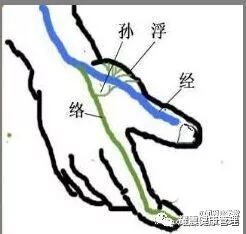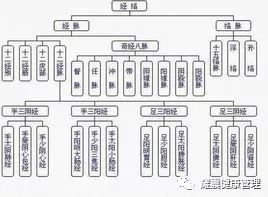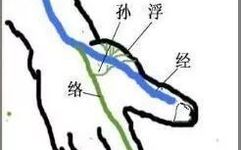 November 30, 2018, the 23rd day of the 10th lunar month,the 5th year of the Earth Dog, the month of the Water Pig, the day of the Yang Tiger, Friday.
November 30, 2018, the 23rd day of the 10th lunar month,the 5th year of the Earth Dog, the month of the Water Pig, the day of the Yang Tiger, Friday.
The meridians in Traditional Chinese Medicine (TCM) refer to the main and branch pathways of qi and blood circulation within the human body. These pathways include the primary meridians (jing mai) and the collaterals (luo mai). The longitudinal main lines are called jing mai, while the branches that extend from the jing mai to various parts of the body are referred to as luo mai. According to the “Lingshu: Meridians”: “The twelve meridians run deep between the flesh, hidden from view; the ones commonly seen are the foot Taiyin above the outer ankle, as they are not concealed. All the floating and commonly seen vessels are collaterals.” The main content of the meridians includes: the twelve primary meridians, twelve meridian branches, eight extraordinary vessels, fifteen collaterals, twelve sinews, and twelve skin areas. Among these, the twelve primary meridians are predominant in the meridian category, while the fifteen collaterals are predominant in the collateral category. They interconnect and spread throughout the body, linking the internal and external organs and limbs into an organic whole.

The collaterals (luo mai) are branches that diverge from the primary meridians, mostly distributed on the body surface. There are fifteen collateral branches, one for each of the twelve primary meridians, plus the collaterals of the Ren (Conception) and Du (Governing) vessels, and the large collateral of the Spleen. Additionally, if we include the large collateral of the Stomach, it can be referred to as the sixteen collateral branches. The smaller collaterals that branch off from the collateral branches are called “sun collaterals,” while the fine collaterals distributed on the skin surface are referred to as “floating collaterals.” The fifteen collaterals play a leading role in the numerous small collaterals throughout the body, primarily serving to enhance the connection between the internal and external meridians at the body surface, allowing the infusion of qi and blood into the surface of the body.

The distribution of the fifteen collateral branches has specific locations, where the collateral branches of the twelve primary meridians emerge from below the elbows and knees, interlinking the internal and external meridians. The collateral of the Ren vessel is distributed in the abdomen, the collateral of the Du vessel is distributed in the back, the large collateral of the Spleen is located on the side of the body, and the large collateral of the Stomach is found below the left breast. The specific locations are as follows: (1) The collateral of the Hand Taiyin: emerges from the Lieque (LU7) point, starting above the wrist joint, and runs towards the Hand Yangming meridian at half an inch behind the wrist; its branches run alongside the Hand Taiyin meridian, entering the palm and spreading to the thenar area. (2) The collateral of the Hand Yangming: emerges from the Pianli (LI6) point, running towards the Hand Taiyin meridian three inches behind the wrist; its branches ascend along the arm, passing through the shoulder, rising to the angle of the jaw, spreading to the teeth, and entering the ear to connect with the Zong (Ren) vessel. (3) The collateral of the Foot Yangming: emerges from the Fenglong (ST40) point, located eight inches above the outer ankle, running towards the Foot Taiyin meridian; its branches ascend along the outer edge of the tibia, connecting to the head and neck, and descending to the throat. (4) The collateral of the Foot Taiyin: emerges from the Gongsun (SP4) point, located one inch behind the first toe joint, running towards the Foot Yangming meridian; its branches enter the abdominal cavity, connecting to the intestines and stomach. (5) The collateral of the Hand Shaoyin: emerges from the Tongli (HT5) point, running one inch behind the wrist towards the Hand Taiyang meridian; its branches diverge one and a half inches behind the wrist, ascending along the meridian into the heart, and connecting to the root of the tongue and the eye system. (6) The collateral of the Hand Taiyang: emerges from the Zhizheng (SI7) point, injecting into the Hand Shaoyin meridian five inches behind the wrist; its branches ascend through the elbow, networking at the shoulder. (7) The collateral of the Foot Taiyang: emerges from the Feiyang (BL58) point, located seven inches above the outer ankle, running towards the Foot Shaoyin meridian. (8) The collateral of the Foot Shaoyin: emerges from the Dazhong (KD4) point, wrapping around the heel from behind the inner ankle, running towards the Foot Taiyang meridian; its branches ascend along the meridian to the pericardium, connecting to the lumbar spine. (9) The collateral of the Hand Jueyin: emerges from the Neiguan (PC6) point, superficially appearing between the two tendons two inches behind the wrist, ascending along the meridian, connecting to the pericardium and linking to the heart. (10) The collateral of the Hand Shaoyang: emerges from the Waiguan (SJ5) point, two inches behind the wrist, circling around the outer side of the arm, entering the chest, and connecting with the Hand Jueyin meridian. (11) The collateral of the Foot Shaoyang: emerges from the Guangming (GB37) point, located five inches above the inner ankle, running towards the Foot Jueyin meridian, descending to connect with the dorsum of the foot. (12) The collateral of the Foot Jueyin: emerges from the Ligou (LR5) point, located five inches above the inner ankle, running towards the Foot Shaoyang meridian; its branches pass through the tibia, ascending to the testicular area, and converging at the penis. (13) The collateral of the Ren vessel: emerges from the Jiutai (CV15) point, descending from the xiphoid process, spreading in the abdomen. (14) The collateral of the Du vessel: emerges from the Changqiang (GV1) point, ascending along both sides of the spine to the neck, spreading over the head; the descending collaterals begin at the scapular area, diverging along the Foot Taiyang meridian, entering the muscles on both sides of the spine. (15) The large collateral of the Spleen: emerges from the Dabao (SP21) point, superficially appearing three inches below the Yuanye (SP16) point, spreading in the chest and flank area. (16) The large collateral of the Stomach: another major branch of the Foot Yangming meridian, named Xuli. It penetrates the diaphragm, networks with the lungs, and emerges below the left breast, with its pulse continuously beating, palpable upon touch. Note: Adding the large collateral of the Stomach can also be referred to as the sixteen collaterals?
According to the “Suwen: Discussion on the Qi of the Balanced Person”: “The large collateral of the Stomach, named Xuli, penetrates the diaphragm and networks with the lungs, emerging below the left breast, its movement responding to clothing, it is the pulse of the ancestral qi.” Hence, there is also the saying of the “sixteen collaterals.”

